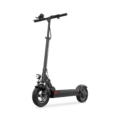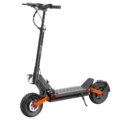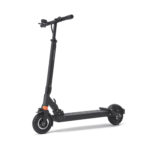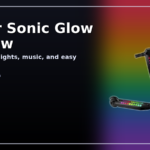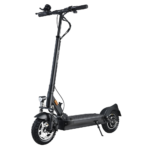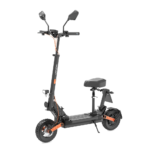- Home
- Scooters
- Electric Scooters
- JOYOR C10 DGT
JOYOR C10 DGT


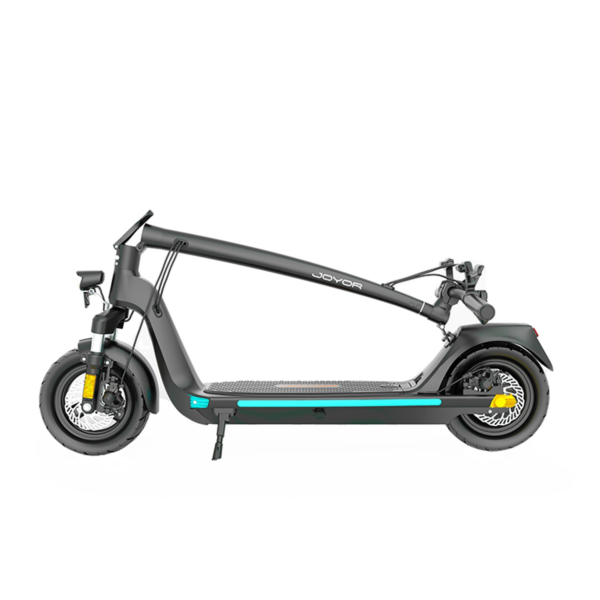
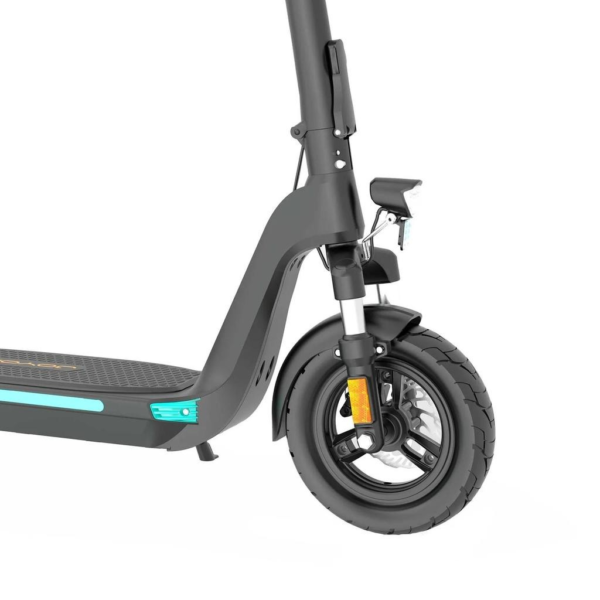
- Battery Range: 22–28 mi (35–45 km)
- Top Speed: 15.5 mph (25 km/h) DGT-limited
- Motor Power: 350–450 W nominal
- Weight Capacity: 220 lb (100 kg)
- Charging Time: ~5–7 h
- Scooter Weight: 30.9 lb (14.0 kg)
PROS
- DGT-compliant speed and lights
- Lightweight and easy to carry
- Low energy use per mile
- Predictable assisted braking
- Great for mixed-mode commutes
CONS
- Speed capped for regulation
- Shorter range than S/Y/T series
- Solid tires ride firm (if equipped)
- Limited hill performance
Table of contents
- What Is the JOYOR C10 DGT?
- How the JOYOR C10 DGT Works
- Key Specifications (clean table)
- Design & Build Quality
- Performance Fundamentals
- Battery, Range & Efficiency
- Ride Quality & Comfort
- Braking & Safety Features
- Portability & Daily Usability
- Maintenance & Care
- Weather & Seasonal Considerations
- JOYOR C10 DGT vs Alternatives
- Who the JOYOR C10 DGT Is (and Isn’t) For
- FAQs
- Glossary
- Closing Thoughts
The JOYOR C10 DGT is a practical, city-friendly electric scooter designed for everyday riders who value comfort, control, and consistent performance. It favors smooth starts, stable cruising, and predictable stopping over flashy numbers. Consequently, the JOYOR C10 DGT suits commuters, students, and new riders who want a balanced, low-drama experience on real streets.
Because the platform emphasizes usable torque, clear cockpit layout, and a sturdier feel than lightweight “last-mile” units, it works for daily trips across town, short errands, and weekend rides along mixed urban routes. Moreover, it keeps maintenance simple and riding stress low.
What Is the JOYOR C10 DGT?
At its core, the JOYOR C10 DGT is a mid-class commuter scooter built around a single rear hub motor, a reliable control system, and a lithium-ion battery sized for daily urban use. The chassis aims for stability at city speeds, with a deck long enough to switch stances and a stem that resists flex when you load the front under braking or bumps. As a result, the scooter feels composed on typical asphalt, pavers, and painted crossings.
This model prioritizes simple, repeatable behavior: steady acceleration, calm steering, and a braking package that feels intuitive after a single ride. Additionally, the overall design leans toward familiar controls and easy maintenance, which lowers the learning curve for new riders and reduces long-term fuss for experienced commuters.
How the JOYOR C10 DGT Works
The system is straightforward. Think of it like a calm, well-tuned bicycle with a gentle assist that adapts to your inputs. In practice, you press to go, squeeze to slow, and steer with a steady mid-bar grip.
Motor. A single rear hub motor provides direct drive. Because it sits in the wheel, there are no chains or belts to adjust. Power delivery feels linear from a standstill and builds smoothly as you roll on the throttle. Furthermore, rear-drive traction keeps the nose stable when you accelerate over paint lines or shallow potholes.
Controller. The controller acts as the scooter’s brain. It meters current to the motor and moderates throttle inputs to prevent twitchy surges. On the road, this feels like a light “cushion” between your thumb and the wheel. Therefore, starts are composed, and transitions between low and medium speeds feel consistent.
Battery. A lithium-ion pack inside the deck powers everything. Capacity varies by region and production run, but the pack is sized for typical city commutes. Because it sits low, it helps stability. The battery includes a battery management system (BMS) that oversees charging and discharge. In everyday riding, that protection helps the pack stay healthy over many cycles.
Throttle. The thumb throttle provides fine control at walking speed and in tight spaces. It also reduces wrist strain during long stretches. Even at low speeds, small inputs yield small changes, which helps in crowds and near curbs.
Brakes. Depending on variant and region, you may see drum, disc, or a combination with electronic motor assistance (“regen”). The lever feel tends to be light at the start, then firmer through the middle of the pull. Consequently, you can modulate braking without abrupt front-end dive or rear lockup.
The net effect is simple: the system emphasizes predictability over drama. Therefore, riders can focus on traffic and terrain rather than juggling twitchy inputs.
Key Specifications (clean table)
Note: Values can vary by market, year, and retailer. Always confirm exact details for your unit at purchase.
| Block | Details |
|---|---|
| General | Category: urban commuter Drive: single rear hub motor Frame: folding aluminum alloy chassis Rider fit: medium cockpit with upright stance |
| Performance & Power | Tuning: smooth starts and linear roll-on Drive mode presets: multiple speed modes for city use Climbing intent: built for moderate hills common in town |
| Battery, Charging & Electrical | Battery: lithium-ion pack with BMS Charging: external charger with deck-side port Charge time: typical for mid-class commuters; overnight top-offs recommended Display: bar or percentage-based battery readout |
| Build & Dimensions | Deck: flat, grippy surface; supports staggered stance Stem: folding column with safety latch Folded form: compact enough for trunk and closet storage Weight class: mid-range commuter (carryable for short distances) |
| Safety & Control | Brakes: mechanical (drum/disc) with potential electronic assist Lights: front headlight and rear brake light; side reflectors on many units Traction: road-biased tires; check pressure regularly |
| Features & Extras | Ride modes, walk assist on some variants, bell, kickstand Cruise Control: present on many units; behavior varies by region Optional app features on select versions |
| Warranty & Compliance | Warranty and local compliance vary by seller and region; retain proof of purchase and follow regional riding rules |
Design & Build Quality
The frame uses a straightforward folding aluminum design that balances stiffness and practicality. The deck is low and long enough to adjust your stance on the fly. Consequently, as you settle into a ride, you can shift your feet diagonally for better shock absorption and steering leverage. This flexibility matters, because a calm scooter starts with a stable platform under your feet.
The stem feels reassuring when you pull on the bar during climbs or brace under braking. While no foldable column eliminates all movement, the JOYOR C10 DGT keeps flex to a mild, predictable level. Therefore, the steering stays composed at typical city speeds, even when the road surface turns lumpy.
Up top, the cockpit adopts a clean, readable display. You get speed, battery status, and mode at a glance. The throttle sits within easy reach of your thumb, and the brake lever offers a familiar bicycle-like pull. Additionally, many units include a bell and a simple button layout, so you can make adjustments without hunting through menus on the move.
Fit-and-finish targets durability. Fasteners are accessible and reasonably protected. Cable routing avoids sharp bends. Fender coverage keeps most spray off the deck and your legs. Altogether, the design is utilitarian rather than flashy, which fits the scooter’s city-first mission.
Performance Fundamentals
The JOYOR C10 DGT does not chase headline acceleration. Instead, it focuses on smooth launches and stable cruising. From a stop, the scooter rolls out without jerkiness, which helps in crosswalks and near crowded sidewalks. This tuning reduces front-end lift and keeps your weight centered, so you can steer precisely through gaps.
At 15–20 mph city speeds, the chassis feels settled. The combination of deck height, steering geometry, and tire contact gives a planted sensation on straight roads and gentle curves. Importantly, the handlebar doesn’t chatter when you cross painted lines or metal grates. As a result, confidence builds quickly for new riders and fatigue drops for daily commuters.
On hills around 7–10%—think long driveways, overpasses, and neighborhood slopes—the scooter holds momentum as long as you enter with some speed. If you slow to a crawl on a steep pitch, you’ll feel the motor work harder, but you still maintain steady progress. Because the controller meters current smoothly, transitions on rolling terrain feel cohesive rather than lurchy. Nevertheless, plan ahead and keep your cadence steady.
Braking performance is consistent. Initial lever pull trims speed without drama, while a deeper squeeze provides stronger bite. If your unit includes electronic motor assistance, you’ll notice a mild “drag” effect when you close the throttle or begin braking. That extra resistance can help settle the chassis before the mechanical brake takes over. Consequently, stops feel progressive and controlled.
Battery, Range & Efficiency
Range depends on several factors: rider weight, speed choice, wind, hills, temperature, tire pressure, and surface roughness. In warm weather on mostly flat routes, you can expect longer distances from each charge. Conversely, cold temperatures, frequent stops, steep hills, and under-inflated tires shorten it.
To ride efficiently, keep a steady pace in a moderate ride mode. Avoid repeated full-throttle bursts to top speed. Instead, roll on gently and cruise at a comfortable mid-range velocity. Because the pack sits low in the deck, you benefit from stability without sacrificing cornering clearance. That placement also helps the BMS manage heat during charging and discharge. Consequently, performance stays more consistent across a full day of riding.
Charging best practices are straightforward:
- Let the scooter rest for 10–20 minutes after riding before charging.
- Use the supplied charger on a dry, ventilated surface.
- Try partial, frequent top-offs for daily use rather than deep cycles every time.
- If storing for weeks, leave the battery around a mid-state of charge.
- Keep the port cap sealed between charges to reduce dust and moisture intrusion.
These habits protect the pack and sustain healthy capacity across seasons. In turn, they reduce voltage sag under load, which helps the scooter feel more responsive as the battery depletes.
Ride Quality & Comfort
Ride comfort starts with your contact points. The deck provides enough length to stagger your feet and bend your knees over bumps. That active stance, combined with road-biased tires, absorbs small cracks and seams. On rougher pavement, you will still feel sharp hits, but the chassis keeps those impulses brief rather than echoing through the stem.
Tire type varies by region, but most units in this class favor pneumatic tires for better grip and comfort. If your unit uses pneumatic rubber, maintain the recommended pressures. Too low, and the scooter feels vague in turns and more vulnerable to pinch flats. Too high, and the ride becomes harsh and skittish over expansion joints. Therefore, staying in the healthy middle preserves grip and steering accuracy.
Ergonomics suit medium builds with a neutral, upright stance. Tall riders can roll the bars slightly forward to add reach. Shorter riders can rotate them back to bring controls closer. Because the handlebar is a single, simple piece, setting it up takes only basic tools and a few minutes. Additionally, a small rotation of the controls can improve thumb comfort on longer rides.
Stem flex is present on any folding scooter, yet it remains modest here. You may notice a slight fore-aft motion when you brake hard or land a larger bump. However, the movement is controlled and predictable, so it doesn’t trigger speed wobbles under normal city riding.
Braking & Safety Features
The braking system prioritizes modulation over sheer clamping force. That means you can feather the lever through traffic without sudden front dive. If your unit includes electronic motor assist, the scooter will slow as soon as you roll off the throttle, which prepares the chassis for the mechanical brake. The combined effect is smooth and confidence-building.
Lighting covers the basics. A forward headlight improves your visibility at dusk and helps others see you from a distance. The rear light brightens under braking, signaling your intentions. Additionally, many units add side reflectors that catch headlights at intersections. Still, you should ride defensively and assume that drivers may not anticipate your speed or path.
Water protection varies by batch and region. Treat the scooter as splash-resistant rather than fully waterproof. Therefore, slow down on soaked roads, avoid deep puddles, and dry the scooter after wet rides. Moisture on brake surfaces reduces bite, so increase following distances until everything dries. Furthermore, wipe down the deck and check the port cap after rain.
Finally, check local rules where you ride. Speed limits, permitted lanes, and lighting requirements differ from place to place. When in doubt, ride a little slower, signal clearly, and yield extra space.
Portability & Daily Usability
The JOYOR C10 DGT folds into a compact, trunk-ready shape. The latch system is straightforward: lower the stem, engage the catch, and lift from the balance point near the deck. Because the scooter sits in the mid-weight class, you can carry it up a short flight of stairs or across a train platform. For longer hauls, roll it whenever possible instead of lifting. Additionally, plan your building entries to avoid doors that force awkward turns.
Storage is simple. Slide it under a desk, lean it in a closet, or park it behind a sofa. If your commute includes a tight elevator, check the diagonal dimension and the door width. Most mid-class scooters fit diagonally without much fuss. Moreover, a small wall hook near the entry can keep the deck off the floor and free up space.
Security is a habit, not a single device. When you need to leave the scooter unattended, lock it through the frame where possible and choose a visible area. Better yet, bring it indoors at work or school. Keep the charger in your bag so you can top up during the day if needed. In practice, small routines like these keep the scooter ready without adding stress.
Maintenance & Care
A calm ownership experience starts with a simple routine. This checklist covers the basics and reduces surprises down the road.
Before each ride
- Squeeze the brake lever to confirm bite.
- Check tire feel by pressing down with your thumb. Inflate if soft.
- Verify the latch is fully engaged and the stem clamp is snug.
- Scan the deck and wheels for debris.
Weekly
- Inspect fasteners on the stem clamp, brake caliper, and fenders.
- Wipe the display and throttle area; confirm smooth thumb movement.
- Listen for new rattles. Then trace and tighten the source.
Monthly
- Set tire pressures with a gauge, not a guess.
- Clean the brake rotor or drum area with an appropriate cleaner.
- Look for cable fray or housing wear at tight bends.
- Review ride mode settings; confirm they match your routes.
Seasonally
- Inspect the folding latch surfaces for wear or burrs.
- Check deck grip; replace or clean if it has gone slick.
- Evaluate battery health by noting any sudden drops under load.
- Refresh lubricant on pivot points where appropriate.
If your unit receives firmware updates through an app, apply changes cautiously. Read the notes, update when stable, and test in a safe area before regular use. In short, the goal is smooth operation, not chasing the newest setting.
Weather & Seasonal Considerations
Rain. Wet roads cut grip and increase stopping distance. Therefore, slow earlier, straighten the scooter before braking, and avoid painted lines and metal plates. Wipe down the scooter after wet rides and open the rubber port caps briefly to release trapped moisture.
Heat. High temperatures can push the battery and tires toward their limits. Park in the shade, let the scooter cool before charging, and avoid over-pressurizing the tires. Additionally, if the deck feels hot after a long climb, take a short break.
Cold. Range drops in cold weather as battery chemistry slows. Pre-warm indoors when possible and ride in a moderate mode. Keep speeds smooth to reduce current spikes. After a cold ride, let the scooter return to room temperature before charging. Consequently, the pack remains healthier over the long term.
Wind. Headwinds drain energy quickly. In gusty conditions, bend your elbows, lower your chest slightly, and choose a steadier pace rather than fighting for top speed. Meanwhile, leave extra room for crosswind gusts near gaps between buildings.
With a little planning, the scooter remains a year-round tool rather than a fair-weather toy.
JOYOR C10 DGT vs Alternatives
EvEvery scooter sits somewhere on the triangle of power, weight, and comfort. The JOYOR C10 DGT aims for the center, which makes it adaptable but not extreme. Consequently, it serves a wide audience without chasing niche performance.
Where it excels
- Daily commuting: Predictable starts and calm steering reduce stress in traffic.
- Mixed routes: It handles neighborhoods, bike lanes, and city streets without demanding constant attention.
- New riders: Gentle throttle mapping and intuitive brakes shorten the learning curve.
- Portability balance: It folds cleanly and remains carryable for short stretches.
Where a different class may fit better
- Ultra-light last-mile: If you carry up multiple flights daily, a lighter class may suit you.
- High-performance: If you want rapid acceleration and very high cruising speeds, look at performance scooters instead.
- Off-road: For rough trails and deep gravel, dedicated suspension and knobby tires are better choices.
- Heavy cargo: If you carry bulky bags often, consider a model with a longer deck or accessory mounts.
Altogether, this balanced personality is the point. The JOYOR C10 DGT trades spectacle for composure, and many riders prefer that for real-world commuting. For riders who want a stronger motor and sportier tuning—while still keeping commuter manners—consider the JOYOR S-PRO DGT.
Who the JOYOR C10 DGT Is (and Isn’t) For
Ideal for
- Urban commuters who want a steady, low-stress ride to work or class.
- Students who need a reliable campus-to-city shuttle with straightforward controls.
- Multi-modal travelers who mix scooters with trains, buses, or car trunks.
- New riders who value quiet manners over aggressive acceleration.
Not ideal for
- Speed chasers who measure rides in top-speed runs.
- Trail explorers who need long-travel suspension and big tires.
- Frequent stair carriers who prioritize the lightest possible frame above all else.
If you see your daily routes in the first list, the JOYOR C10 DGT likely fits you well. Otherwise, a specialized category may serve you better.
FAQs
1) How fast does the JOYOR C10 DGT feel in normal city use?
It feels composed rather than frantic. Acceleration is smooth, and the chassis stays settled at typical urban speeds. Consequently, it’s easy to ride in busy areas.
2) Can I ride hills on my commute?
Yes, on moderate grades. Enter with some speed and use a steady throttle. The scooter maintains momentum on common 7–10% slopes. Nevertheless, very steep pitches will slow most mid-class commuters.
3) How should I charge for daily use?
Top off when convenient, avoid repeated deep drains, and let the scooter cool before charging after hard rides. Additionally, keep the port cap sealed between sessions.
4) Is the JOYOR C10 DGT good for new riders?
It’s friendly to beginners. The throttle is easy to modulate, and the braking feel is predictable, which helps confidence. Moreover, the cockpit is simple and readable.
5) Does it have Cruise Control?
Many units do, though behavior can vary by region. If present, it typically engages after holding a steady speed for a few seconds. Therefore, use it on open stretches rather than in dense traffic.
6) What maintenance does it need most often?
Tire pressure checks and brake adjustments. Also inspect the folding latch and key fasteners weekly, which prevents small issues from growing. In addition, clean the brake surfaces monthly.
7) Where can I find a “JOYOR C10 DGT overview” that keeps things simple?
You’re reading one. This guide focuses on real-world riding, care, and setup tips without relying on hard-to-verify numbers.
Glossary
Ah (amp-hours). A measure of how much charge a battery can hold. Higher Ah suggests more potential ride time, all else equal.
Wh (watt-hours). Battery energy capacity. Multiply nominal voltage by amp-hours to estimate total energy. Consequently, Wh helps compare packs across models.
Controller. The electronic unit that manages power delivery from the battery to the motor. It shapes throttle response and protects components.
FOC (field-oriented control). A control strategy that smooths motor operation and improves efficiency. In practice, it often feels like calmer starts.
Regen (regenerative braking). The motor acts as a generator to create resistance when slowing, returning a small amount of energy to the battery. However, it is not a substitute for mechanical brakes.
BMS (battery management system). Protection circuitry inside the pack that manages charge, discharge, and cell balancing. Therefore, it supports pack longevity.
Stem flex. The small, perceptible motion in the folding column under load. A moderate amount is normal on folding scooters.
IP rating. An ingress protection code indicating dust and water resistance. Higher ratings suggest better sealing; however, none imply full submersion.
Torque. Rotational force from the motor. More torque helps with starts and hills, especially when carrying a backpack.
Kickstand spread. How widely the kickstand sets the scooter from vertical. A wider spread usually improves parking stability.
Contact patch. The area of tire touching the road. Bigger patches can aid grip, especially in turns and under braking.
Mode profiles. Pre-set speed and power limits that change how the scooter behaves. Consequently, you can tailor behavior to route and rider.
Voltage sag. Temporary voltage drop under heavy load. It can reduce punch late in a ride if the battery is low.
Pre-load stance. Bending your knees and bracing before a bump or stop. This stabilizes the scooter and your balance.
Wheelbase. The distance between front and rear wheel centers. A longer wheelbase tends to improve straight-line stability.
Closing Thoughts
The JOYOR C10 DGT does its best work when you ask it to be a calm, dependable partner. It carries you to work, class, or the café without demanding attention at every crack in the road. The motor starts you gently. The brakes slow you with predictable bite. The chassis stays composed through everyday city textures. Moreover, the ownership habits are simple and the learning curve stays short.
If you want a balanced, confidence-building commuter that feels at home in real traffic and real weather, the JOYOR C10 DGT hits that target. Conversely, if you want extreme speed or rugged off-road capability, a specialized category will serve you better.
Specifications
General
| Model The Model specifies the exact version or name of the scooter. It helps identify its unique design, features, and specifications within the manufacturer’s product line. Knowing the model makes it easier to compare options, find compatible accessories, or look up support information. | C10 DGT |
| Brand The Brand identifies the manufacturer or company that designs and produces the scooter. A trusted brand is a sign of quality, reliability, and good customer support. Well-known brands often have higher standards for safety, performance, and after-sales service, giving you more confidence in your purchase. | JOYOR |
| Release Date The Release Date indicates when the scooter model was officially launched on the market. This helps you know how current the design, technology, and features are. A newer release date often means updated components, improved performance, and the latest safety or smart features. | 17 November 2025 |
| Recommended Age Recommended Age indicates the minimum age range that the scooter is designed for, based on safety, size, and ease of use. Following the recommended age helps ensure that riders can handle the scooter’s speed, weight, and controls comfortably and safely. Always check local laws and use protective gear, especially for younger riders. | Recommended 14+ |
Performance & Power
| Motor Power (Wattage) What it means: The motor power, measured in watts (W), shows how strong the scooter’s electric motor is. Why it matters: Higher wattage usually means better acceleration, more torque, and improved performance on hills or rough terrain. For example, a 250W motor is good for flat city roads and light riders, while a 500W or 1000W motor provides more power for faster speeds or climbing steep inclines. | 350–450 W nominal |
| Top Speed The Top Speed indicates the maximum speed that the scooter can reach under optimal conditions. It’s usually measured on level ground with a fully charged battery and an average rider weight. A higher top speed allows you to travel longer distances faster, but always ensure you ride within legal speed limits and your personal comfort zone for safety. | 25 km/h limited |
| Battery Capacity Battery Capacity refers to the total amount of energy the scooter’s battery can store, usually measured in ampere-hours (Ah) or watt-hours (Wh). A higher battery capacity means you can ride longer distances on a single charge, reducing the need for frequent recharging. Keep in mind that actual range can vary depending on rider weight, terrain, speed, and weather conditions. | 36–48 V 10–12 Ah |
| Estimated Range per Charge The Estimated Range per Charge indicates the average distance the scooter can travel on a single full battery charge. This range is calculated under optimal conditions, such as flat terrain, moderate speed, and average rider weight. Real-world range may vary depending on riding style, terrain, weather, and load. A longer range means fewer recharges and greater freedom for longer trips. | 35–45 km |
| Hill Climb Ability Hill Climb Ability describes the maximum incline or slope that the scooter can handle while maintaining stable performance. It’s typically expressed as a percentage or in degrees. A higher hill climb rating means the scooter can tackle steeper hills without losing too much speed or power. Actual climbing performance may vary based on rider weight, battery charge, and terrain conditions. | Up to 12° grades |
| Drive System The Drive System refers to how power from the motor is delivered to the wheels. Electric scooters typically use either a hub motor (directly integrated into the wheel) or a chain/belt drive system. A high-quality drive system ensures smooth acceleration, efficient power transfer, and low maintenance. The choice of drive system affects performance, noise level, and overall ride experience. | Rear hub motor (RWD) |
Charging & Electrical
| Charging Time Charging Time indicates how long it takes to fully recharge the scooter’s battery from empty to 100% using the standard charger provided. Faster charging means less downtime and more time on the road. Actual charging time may vary slightly depending on battery capacity, charger output, and environmental conditions. | Approx. 5–7 hours |
| Battery Type Battery Type refers to the specific technology used in the scooter’s battery, which affects performance, lifespan, weight, and charging time. Most modern electric scooters use high-quality lithium-ion (Li-ion) batteries because they offer a good balance of energy density, durability, and low maintenance. A reliable battery type ensures consistent power delivery and longer riding ranges. | Li-ion with Smart BMS |
| Removable Battery A Removable Battery means the battery pack can be easily detached from the scooter for convenient charging and replacement. This feature allows you to charge the battery separately, swap it with a spare for extended range, or securely store it indoors in extreme weather. Removable batteries add flexibility and make it easier to keep your scooter powered up wherever you are. | No |
| Regenerative Braking Regenerative Braking is an energy-saving feature that converts some of the energy normally lost during braking back into battery power. When you slow down or brake, the motor works in reverse to generate electricity, which helps extend the scooter’s range and improves overall efficiency. This system also reduces wear on traditional brake components, leading to lower maintenance over time. | Front e-brake + rear drum |
| Lighting Lighting refers to the built-in front and rear lights that enhance visibility and safety when riding in low-light conditions or at night. Good lighting helps you see the road ahead and ensures that other road users can see you. Many scooters include LED headlights, taillights, and sometimes brake lights or side reflectors for added safety and compliance with local traffic regulations. | DGT lighting + reflectors + bell |
Build & Dimensions
| Scooter Weight Scooter Weight refers to the total weight of the scooter when fully assembled, including the battery. This affects how easy it is to carry, lift, and store the scooter when not in use. A lighter scooter is more portable and convenient for commuting, especially if you need to carry it upstairs or onto public transport. Keep in mind that a sturdy frame and quality components may add to the weight but also contribute to better durability and ride stability. | 30.9 lb (14.0 kg) |
| Maximum Rider Weight Maximum Rider Weight indicates the highest rider weight that the scooter is designed to safely support while maintaining optimal performance and stability. Staying within this limit helps ensure reliable acceleration, braking, and climbing ability, and it protects the frame, suspension, and motor from excessive strain. Exceeding the recommended limit may reduce performance and increase wear on components. | 220 lb (100 kg) |
| Deck Size Deck Size refers to the dimensions of the scooter’s standing platform. A wider and longer deck provides more foot space, allowing you to stand comfortably and adjust your stance while riding. A well-sized deck improves balance and stability, especially on longer rides or at higher speeds. Compact decks, on the other hand, help keep the scooter lightweight and portable. | Slim deck; compact stance |
| Handlebar Height Handlebar Height refers to the distance from the deck to the handlebars, which affects your riding posture and comfort. An appropriate handlebar height helps you maintain good balance, reduces strain on your back and arms, and makes steering more comfortable. Some scooters have adjustable handlebars to fit riders of different heights, while others have a fixed height for a streamlined design. | Adult fixed bar height |
| Folding Mechanism The Folding Mechanism describes how easily and securely the scooter can be folded for carrying and storage. A well-designed folding system lets you quickly collapse the scooter into a compact size, making it convenient to transport on public transit, store under a desk, or fit into a car trunk. Look for sturdy latches and safety locks to ensure the scooter stays firmly in place when folded or unfolded. | Quick folding latch |
| Dimensions Folded Dimensions indicate the size of the scooter when it’s fully folded. This measurement shows how much space the scooter will take up when stored or carried, making it easier to check if it will fit in your car trunk, under a desk, or in a closet. Compact folded dimensions are ideal for commuters who need to bring their scooter on public transport or store it in tight spaces. | 41.3 × 17.7 × 18.5 in (folded) |
| Material Material refers to the primary construction materials used for the scooter’s frame and key components. High-quality materials like aircraft-grade aluminum, reinforced steel, or durable composites provide strength, stability, and a lighter overall weight. A sturdy material ensures the scooter can handle daily wear and tear while maintaining safety and performance. | Aluminum alloy |
Safety & Control
| Brake Type(s) Brake Type(s) describe the braking systems the scooter uses to help you slow down or stop safely. Common brake types include mechanical brakes (like drum or disc brakes), electronic brakes, and foot brakes. Many scooters combine multiple braking systems for added safety and shorter stopping distances. The type and quality of brakes affect your control, especially when riding at higher speeds or on slopes. | Front e-brake + rear drum |
| Suspension Suspension refers to the system that absorbs shocks and vibrations while riding, providing a smoother and more comfortable ride over uneven or rough surfaces. Scooters may have front suspension, rear suspension, or dual suspension for better shock absorption and stability. Good suspension helps reduce rider fatigue and improves control, especially when riding on bumpy roads or off-road paths. | None |
| Tire Type Tire Type refers to the kind of tires the scooter uses, which directly affects ride comfort, traction, and maintenance. Common types include solid (airless) tires, pneumatic (air-filled) tires, or hybrid options. Pneumatic tires offer better shock absorption and a smoother ride on rough surfaces, while solid tires are puncture-proof and require less upkeep. The right tire type helps ensure safe handling and a comfortable ride in different conditions. | Honeycomb solid or pneumatic by variant |
| Tire Size Tire Size indicates the diameter and width of the scooter’s tires, which affect ride comfort, stability, and how well the scooter handles different terrains. Larger tires generally offer better shock absorption and a smoother ride over bumps and rough surfaces, while smaller tires keep the scooter lighter and more portable. Choosing the right tire size helps ensure a balance between agility and comfort. | 8.5–10 inch class |
| Kickstand The Kickstand is a built-in stand that allows you to park your scooter upright when it’s not in use. A sturdy kickstand keeps the scooter stable and prevents it from tipping over, protecting it from scratches and damage. It also makes storing and accessing your scooter more convenient, whether you’re at home, work, or on the go. | Side kickstand |
| Water Resistance Rating Water Resistance Rating indicates how well the scooter is protected against water and moisture, usually shown as an IP (Ingress Protection) rating. This rating helps you understand whether the scooter can handle light rain, splashes, or wet roads without damage. While most scooters are not fully waterproof, a good water resistance rating adds peace of mind when riding in changing weather conditions. Always avoid deep puddles or submerging the scooter to protect its electrical components. | IPX4 body |
Features & Extras
| Display/Console The Display (or Console) shows important real-time information about your ride, helping you monitor your scooter’s status at a glance. Typical displays show speed, battery level, distance traveled, and riding mode. Some models also include additional features like Bluetooth connectivity, app integration, or backlighting for better visibility at night. A clear and easy-to-read display enhances safety and convenience on every trip. | LED dashboard |
| Ride Modes Ride Modes refer to the different speed and power settings you can choose to match your riding style or road conditions. Common modes include eco for maximum range and energy efficiency, standard for everyday balance, and sport or turbo for higher speed and stronger acceleration. Switching between ride modes allows you to customize performance, conserve battery, and ride safely in various environments. | Eco, Drive |
| Smart App Connectivity Smart App Connectivity lets you pair your scooter with a dedicated mobile app via Bluetooth. Using the app, you can monitor real-time ride stats like speed, battery level, and range, adjust settings such as ride modes or cruise control, lock the scooter for added security, and sometimes receive firmware updates. This feature adds convenience and allows you to personalize your riding experience right from your smartphone. | App-free basic operation |
| Anti-Theft System The Anti-Theft System helps protect your scooter from unauthorized use or theft. This feature can include built-in alarms, electronic motor locks, GPS tracking, or remote locking through a mobile app. A good anti-theft system provides peace of mind when parking your scooter in public spaces, adding an extra layer of security to safeguard your investment. | N/A |
| Cruise Control Cruise Control allows you to maintain a steady speed without continuously holding the throttle. This feature makes longer rides more comfortable by reducing hand fatigue and providing a smoother, more relaxed riding experience — especially on flat, open roads or bike lanes. For safety, cruise control can usually be easily activated or deactivated while riding. | Yes (cruise control) |
| Accessories Included Accessories Included lists the additional items that come with the scooter to enhance your riding experience and convenience. Common accessories may include a charger, kickstand, bell, lights, phone holder, or carrying strap. These extras add value by making your scooter safer, easier to use, and ready to ride straight out of the box. | Bell, reflectors, charger |
Warranty & Compliance
| Warranty Period The Warranty Period indicates how long the manufacturer guarantees the scooter against defects in materials and workmanship under normal use. A good warranty provides peace of mind, showing the brand’s confidence in its product quality. Always check what parts are covered, such as the frame, battery, and motor, and follow the maintenance guidelines to keep your warranty valid. | 12 months typical |
| Certifications Certifications confirm that the scooter meets specific safety, quality, and environmental standards set by recognized organizations or regulatory bodies. Common certifications may include CE, RoHS, UL, or other local compliance marks, depending on your region. These certifications ensure that the scooter is manufactured to high standards and is safe and legal to use in your country. | Spanish DGT compliance |


